List of national flags of sovereign states

- The flag of Brazil being digitally drawn on a computer.
- The flag of Papua New Guinea on the patch of a soldier.
- A sports fan waving the flag of South Africa.
- Giant flag of Turkey made of Lego bricks.
- Flag of the United States on the moon during the Apollo 15 moon landing.
- Flags of the United Kingdom and India are hung during a political meeting.
- Flag of Palestine prominently displayed on West Bank Wall graffiti art.
- Hoisted Nordic cross flags flying upon poles.
- A pair of citizens display the flag of China at Antarctica.
All 195 member states and 2 observer states of the United Nations, in addition to several de facto states, represent themselves with national flags. National flags generally contain symbolism of their respective state and serve as an emblem which distinguishes themselves from other states in international politics. National flags are adopted by governments to strengthen national bonds and legitimate formal authority. Such flags may contain symbolic elements of their peoples, militaries, territories, rulers, and dynasties. The flag of Denmark is the oldest flag still in current use as it has been recognized as a national symbol since the 13th century.
Background and definitions
[edit]According to the Collins English Dictionary, a national flag is "a flag that represents or is an emblem of a country."[1] The word country can be used to refer to a sovereign state, sometimes also called an independent state.[2] It is customary in international law that states adopt a flag to distinguish themselves from other states.[3]
National flags are considered to "provide perhaps the strongest, clearest statement of national identity," and governments have used them to promote and create bonds within the country, motivate patriotism, honor the efforts of citizens, and legitimate formal authority.[4] Throughout history, elements within flags have been used to symbolize rulers, dynasties, territories, militaries, and peoples of their respective countries.[5] Flags also conceptually represent a country's core values, such as group membership and love for the country.[6] In 1975, American vexillologist Whitney Smith stated thus regarding the role of flags in society:[7][8][9]
So strong is the tradition of flags, we may not be far from the truth in surmising that there is a law – not of nature, but of human society – which impels man to make and use flags. There is perhaps no more striking demonstration of this than the fact that, despite the absence of any international regulation or treaty requiring of a national flag, without exception every country has adopted at least one.
— Whitney Smith, Flags Through the Ages and Across the World, p. 32
According to the Oxford English Dictionary, a sovereign state is "a state or nation with a defined territory and a permanent population, which administers its own government, and which is recognized as not subject to or dependent upon another power."[10] The amount of sovereign states in the world is generally derived from the number of member states of the United Nations (UN), although non-member states do exist,[11] with such states being called de facto states.[12] As of 2024, the UN currently includes 193 member states and 2 permanent observer states: Palestine and Vatican City.[13][14] De facto states include Northern Cyprus,[15] Abkhazia,[16] South Ossetia,[17] Transnistria,[18] Kosovo,[19] the Sahrawi Republic,[20] Somaliland,[21] and Taiwan.[12]
The oldest flag of a sovereign state which is currently in use is the flag of Denmark, which has been recognized as a national symbol of the country since the 13th century, although the current version was officially adopted in 1867.[22][23] All 193 member states and 2 observer states are represented by their respective flags at the Headquarters of the United Nations in New York City.[24]
Flags of UN member states and observer states
[edit]— No data
| Flag(s) | State | Aspect ratio | Date of latest adoption[a] | Designer(s) | Description | Refs. |
|---|---|---|---|---|---|---|
 | Afghanistan[b] | 1∶2 | August 15, 2021 | — | White with a black Shahada in Thuluth script in the center. Hoist side depicted to right. | [27][28][29][30] |
 | 2∶3 | August 19, 2013 | — | Three equal vertical bands of black (hoist side), red, and green, with the national emblem[c] in white centered on the red band and slightly overlapping the other 2 bands. | [27][31][32][33][34][35] | |
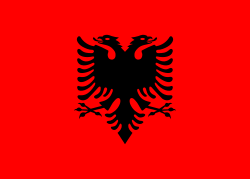 | Albania | 5∶7 | April 7, 1992 | — | Red with a black double-headed eagle in the center. | [36][37][38][39][40] |
 | Algeria | 2∶3 | July 3, 1962 | Disputed[d] | Two equal vertical bands of green (hoist side) and white; a red, five-pointed star within a red crescent centered over the two-color boundary. | [41][42][43][44] |
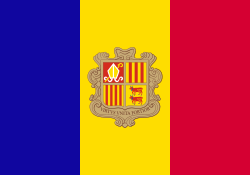 | Andorra | 7∶10 | May 5, 1993 | — | Three vertical bands of blue (hoist side), yellow, and red, with the national coat of arms centered in the yellow band; the latter band is slightly wider than the other 2 so that the ratio of band widths is 8:9:8. | [45][46][47][48][49] |
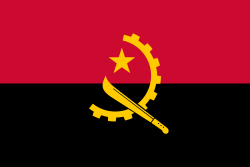 | Angola | 2∶3 | November 11, 1975 | Henrique de Carvalho Santos | Two equal horizontal bands of red (top) and black with a centered yellow emblem consisting of a five-pointed star within half a cogwheel crossed by a machete (in the style of a hammer and sickle). | [50][51][52][53][54] |
 | Antigua and Barbuda | November 1, 1981 | Reginald Samuel | Red, with an inverted isosceles triangle based on the top edge of the flag; the triangle contains three horizontal bands of black (top), light blue, and white, with a yellow rising sun in the black band. | [55][56][57][58] | |
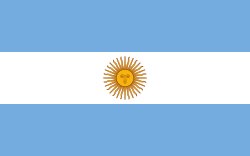 | Argentina | 5∶8 | November 23, 2010 | Manuel Belgrano | Three equal horizontal bands of sky blue (top), white, and sky blue; centered in the white band is a radiant yellow sun with a human face (delineated in brown) known as the Sun of May. | [59][60][61][62][63] |
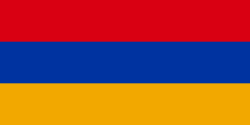 | Armenia | 1∶2 | August 24, 1990 | Three equal horizontal bands of red (top), blue, and orange. | [64][65][66][67][68][69] | |
 | Australia | February 14, 1954 |
| Blue with the flag of the United Kingdom in the upper hoist-side quadrant and a large seven-pointed star in the lower hoist-side quadrant known as the Commonwealth or Federation Star; on the fly half is a representation of the Southern Cross constellation in white with one small, five-pointed star and four larger, seven-pointed stars. | [70][71][72][73][74][75] | |
 | Austria | 2∶3 | May 1, 1945 | — | Three equal horizontal bands of red (top), white, and red. | [76][77][78][79] |
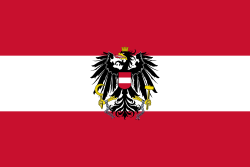 | — | Three equal horizontal bands of red (top), white, and red with the coat of arms of Austria in the center. | ||||
 | Azerbaijan | 1∶2 | August 30, 1991 | — | Three equal horizontal bands of sky blue (top), red, and green; a vertical crescent moon and an eight-pointed star in white are centered in the red band. | [80][81][67][82][83][84] |
 | The Bahamas | July 10, 1973 | Hervis Bain | Three equal horizontal bands of aquamarine (top), gold, and aquamarine, with a black equilateral triangle based on the hoist side. | [85][86][87][88][89] | |
 | Bahrain | 3∶5 | February 14, 2002 | — | Red with a white serrated band (five white points) on the hoist side. | [90][91][92][93][94][95] |
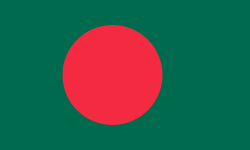 | Bangladesh | January 17, 1972 | Quamrul Hassan | Green field with a large red disk shifted slightly to the hoist side of center. | [96][97][98][99][100][101] | |
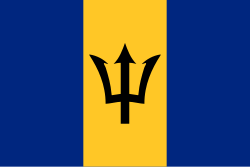 | Barbados | 2∶3 | November 30, 1966 | Grantley Prescod | Three equal vertical bands of ultramarine blue (hoist side), gold, and ultramarine blue with the head of a black trident centered on the gold band. | [102][103][104][105][106] |
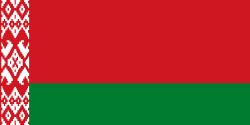 | Belarus | 1∶2 | May 1, 2012 | —.[f] | Red horizontal band (top) and green horizontal band one-half the width of the red band; a white vertical stripe on the hoist side bears Belarusian national ornamentation in red. | [107][108][109][110][111] |
 | Belgium | 13∶15 | January 23, 1831 | Three equal vertical bands of black (hoist side), yellow, and red. | [112][113][114][115][116][117] | |
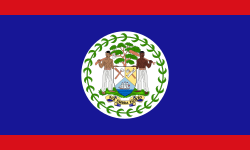 | Belize | 3:5 | September 21, 1981 |
| Royal blue with a narrow red stripe along the top and the bottom edges; centered is a large white disk bearing the coat of arms. | [118][119][120][121][122][123] |
 | Benin | 2:3 | August 1, 1960 | — | Two equal horizontal bands of yellow (top) and red with a vertical green band on the hoist side. | [124][125][126][127] |
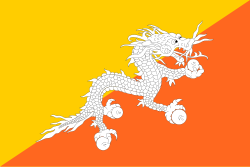 | Bhutan | June 8, 1972 | Mayeum Choying Wangmo Dorji | Divided diagonally from the lower hoist-side corner; the upper triangle is yellow and the lower triangle is orange; centered along the dividing line is a large black and white Druk facing away from the hoist side. | [128][129][130][100][131][132] | |
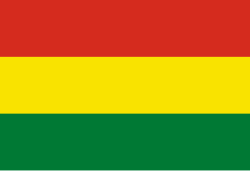 | Bolivia | August 5, 2009 | — | Three equal horizontal bands of red (top), yellow, and green. | [133][134][61][135][136][137][138][139] | |
 | — | Three equal horizontal bands of red (top), yellow, and green with the coat of arms centered on the yellow band. | ||||
 | 1∶1 | Germán Choquehuanca | A grid of 49 squares distributed in 7 columns by 7 rows, arranged in diagonal bands of 7 colors (white, yellow, orange, red, purple, blue, green) with white on the main diagonal. | |||
 | Bosnia and Herzegovina | 1:2 | February 4, 1998 |
| A wide blue vertical band on the fly side with a yellow isosceles triangle abutting the band and the top of the flag; the remainder of the flag is blue with seven full five-pointed white stars and two half stars top and bottom along the hypotenuse of the triangle. | [140][141][142][143][144] |
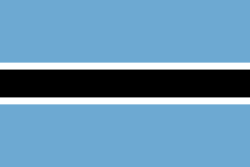 | Botswana | 2:3 | September 30, 1966 | George Winstanley | Light blue with a horizontal white-edged black stripe in the center. | [145][146][147][148][143][144] |
 | Brazil | 7:10 | May 11, 1992 | Green with a large yellow diamond in the center bearing a blue globe with 27 white stars (one for each state and the Federal District) arranged as in the sky over Rio de Janeiro at 8:30 a.m. on November 15, 1889, and containing a banner with the national motto ORDEM E PROGRESSO (lit. 'Order and progress'). | [149][150][151][152][153] | |
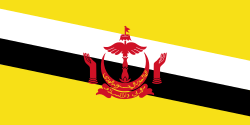 | Brunei | 1:2 | January 1, 1984 | — | Yellow with two diagonal bands of white (top, almost double width) and black starting from the upper hoist side; the national emblem in red is superimposed at the center. | [154][155][156][157][158] |
 | Bulgaria | 3:5 | November 27, 1990 |
| Three equal horizontal bands of white (top), green, and red. | [159][160][161][162][163] |
 | Burkina Faso | 2:3 | August 4, 1984 | Ferdinand Dabiré | Two equal horizontal bands of red (top) and green with a yellow five-pointed star in the center. | [164][165][166][167][168] |
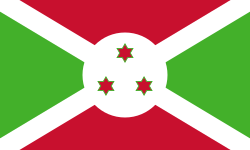 | Burundi | 3:5 | September 27, 1982 | — | Divided by a white diagonal cross into red panels (top and bottom) and green panels (hoist side and fly side) with a white disk superimposed at the center bearing three red six-pointed stars outlined in green arranged in a triangular design (one star above, two stars below). | [169][170][171][172] |
 | Cambodia | 2:3 | June 30, 1993 | — | Three horizontal bands of blue (top), red (double width), and blue with a white, three-towered temple, representing Angkor Wat, outlined in black in the center of the red band. | [173][174][175][176][156] |
 | Cameroon | May 20, 1975 | — | Three equal vertical bands of green (hoist side), red, and yellow, with a yellow five-pointed star centered in the red band. | [177][178][179][180] | |
 | Canada | 1:2 | February 15, 1965 | George Stanley | Two vertical bands of red (hoist and fly side, half width) with a white square between them; an 11-pointed red maple leaf is centered in the white square. | [181][182][183][184][185][186] |
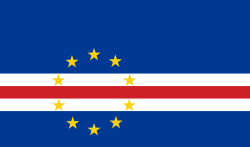 | Cape Verde | 10:17 | September 25, 1992 | Pedro Gregório | Five unequal horizontal bands; the top-most band of blue - equal to one half the width of the flag - is followed by three bands of white, red, and white, each equal to 1/12 of the width, and a bottom stripe of blue equal to one quarter of the flag width; a circle of 10 yellow, five-pointed stars is centered on the red stripe and positioned 3/8 of the length of the flag from the hoist side. | [187][188][189][190][126][191] |
 | Central African Republic | 3:5 | August 13, 1960 | Barthélemy Boganda | Four equal horizontal bands of blue (top), white, green, and yellow with a vertical red band in center; a yellow five-pointed star to the hoist side of the blue band. | [192][193][194][179][195] |
 | Chad | 2:3 | November 6, 1959 | Naiyia Amina Goudja | Three equal vertical bands of blue (hoist side), gold, and red. | [196][197][198][179][199] |
 | Chile | October 18, 1817 | Unclear[g] | Two equal horizontal bands of white (top) and red; a blue square the same height as the white band at the hoist-side end of the white band; the square bears a white five-pointed star in the center. | [200][201][202][61][203][204] | |
 | China | October 1, 1949 | Zeng Liansong | Red with a large yellow five-pointed star and four smaller yellow five-pointed stars (arranged in a vertical arc toward the middle of the flag) in the upper hoist-side corner. | [205][206][207][208] | |
 | Colombia | November 26, 1861 | — | Three horizontal bands of yellow (top, double-width), blue, and red. | [209][210][211][212][213][214] | |
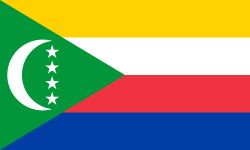 | Comoros | 3:5 | December 23, 2001 | Suzanne Gauthier[h] | Four equal horizontal bands of yellow (top), white, red, and blue, with a green isosceles triangle based on the hoist; centered within the triangle is a vertical white crescent moon with the convex side facing the hoist and four white, five-pointed stars placed vertically in a line between the points of the crescent. | [215][216][217][218] |
 | Democratic Republic of the Congo | 3:4 | February 18, 2006 | Henry Morton Stanley (allegedly) | Sky blue field divided diagonally from the lower hoist corner to upper fly corner by a red stripe bordered by two narrow yellow stripes; a yellow, five-pointed star appears in the upper hoist corner | [219][220][171][221][222] |
 | Republic of the Congo | 2:3 | June 10, 1991 | — | Divided diagonally from the lower hoist side by a yellow band; the upper triangle (hoist side) is green and the lower triangle is red. | [223][224][225][171][226] |
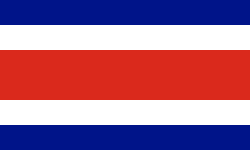 | Costa Rica | 3:5 | September 29, 1848 | Pacífica Fernández Oreamuno | Five horizontal bands of blue (top), white, red (double width), white, and blue. | [227][228][229][230][231][232] |
 | May 5, 1998 | — | Five horizontal bands of blue (top), white, red (double width), white, and blue, with the coat of arms in a white elliptical disk placed toward the hoist side of the red band. | |||
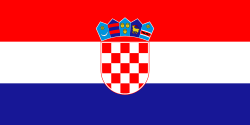 | Croatia | 1:2 | December 22, 1990 | Miroslav Šutej | Three equal horizontal bands of red (top), white, and blue superimposed by the coat of arms. | [233][234][235][236][237] |
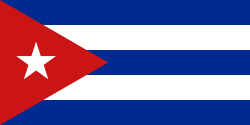 | Cuba | May 20, 1902 | Miguel Teurbe Tolón | Five equal horizontal bands of blue (top, center, and bottom) alternating with white; a red equilateral triangle based on the hoist side bears a white, five-pointed star in the center. | [238][239][240][87][241] | |
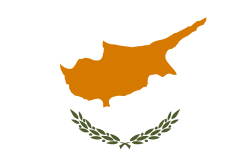 | Cyprus | 2:3 | April 24, 2006 | İsmet Güney | Centered on a white field is a copper-colored silhouette of the island above two olive-green-colored, crossed olive branches. | [242][243][244][245][162][246] |
 | Czech Republic | January 1, 1993 | Jaroslav Kursa (allegedly) | Two equal horizontal bands of white (top) and red with a blue isosceles triangle based on the hoist side. | [247][248][249][250][251][252] | |
 | Denmark[i] | 28:37 | June 15, 1219 | — | Red with a white Nordic cross that extends to the edges of the flag; the vertical part of the cross is shifted to the hoist side. | [23][77][253][254][255][256][257][258] |
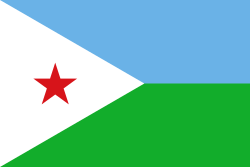 | Djibouti | 2:3 | June 27, 1977 | — | Two equal horizontal bands of light blue (top) and light green with a white isosceles triangle based on the hoist side bearing a red five-pointed star in the center. | [259][260][261][262] |
 | Dominica | 1:2 | November 3, 1990 | Alwin Bully | Green with a centered cross of three equal bands - the vertical part is yellow (hoist side), black, and white and the horizontal part is yellow (top), black, and white; superimposed in the center of the cross is a red disk bearing a Sisserou parrot, unique to Dominica, encircled by 10 green, five-pointed stars edged in yellow. | [263][264][265][57][266] |
 | Dominican Republic | 5:8 | November 6, 1844 | Juan Pablo Duarte | A centered white cross that extends to the edges divides the flag into four rectangles - the top ones are ultramarine blue (hoist side) and vermilion red, and the bottom ones are vermilion red (hoist side) and ultramarine blue; a small coat of arms is at the center of the cross. | [267][268][269][270] |
 | Ecuador | 2:3 | January 10, 1910 | — | Three horizontal bands of yellow (top, double width), blue, and red with the coat of arms superimposed at the center of the flag. | [271][272][273][213][274] |
 | Egypt | October 4, 1984 | ʻAlī Kāmil al-Dīb | Three equal horizontal bands of red (top), white, and black; the national coat of arms (a gold Eagle of Saladin facing the hoist side with a shield superimposed on its chest above a scroll bearing the name of the country in Arabic) centered in the white band. | [275][276][277][278][279][280][281][282] | |
 | El Salvador | 189:335 | September 14, 1972 | — | Three equal horizontal bands of cobalt blue (top), white, and cobalt blue with the national coat of arms centered in the white band. | [283][284][285][286][231][287] |
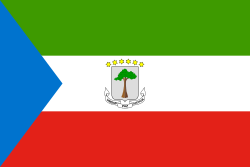 | Equatorial Guinea | 2:3 | August 21, 1979 | — | Three equal horizontal bands of green (top), white, and red, with a blue isosceles triangle based on the hoist side and the coat of arms centered in the white band; the coat of arms has six yellow six-pointed stars (representing the mainland and five offshore islands) above a gray shield bearing a silk-cotton tree and below which is a scroll with the motto UNIDAD, PAZ, JUSTICIA (lit. 'Unity, Peace, Justice'). | [288][289][179][290] |
 | Eritrea | 1:2 | 1995 | — | Red isosceles triangle (based on the hoist side) dividing the flag into two right triangles; the upper triangle is green, the lower one is blue; a gold wreath encircling a gold olive branch is centered on the hoist side of the red triangle. | [291][292][261][293] |
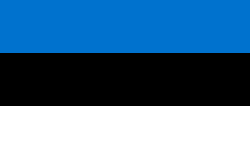 | Estonia | 7:11 | November 21, 1918 | Aleksander Mõttus | Three equal horizontal bands of blue (top), black, and white. | [294][295][296][297] |
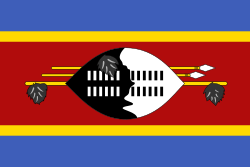 | Eswatini | 2:3 | September 6, 1968 | Sobhuza II | Three horizontal bands of blue (top), red (triple width), and blue; the red band is edged in yellow; centered in the red band is a large black and white Nguni shield covering two spears and a staff decorated with feather tassels, all placed horizontally. | [298][299][300][301] |
 | Ethiopia | 1:2 | February 6, 1996 | — | Three equal horizontal bands of green (top), yellow, and red, with a yellow pentagram and single yellow rays emanating from the angles between the points on a light blue disk centered on the three bands. | [302][303][261][304] |
 | Fiji | October 10, 1970 | Tessa Mackenzie | Light blue with the flag of the United Kingdom in the upper hoist-side quadrant and the Fijian shield centered on the outer half of the flag; the shield is taken from Fiji's coat of arms. | [305][306][307][308][309] | |
 | Finland | 11:18 | January 1, 1995 | Zacharias Topelius | White with a blue Nordic cross. | [310][311][312][313] |
 | France | 2:3 | March 5, 1848 | Jacques-Louis David | Three equal vertical bands of blue (hoist side), white, and red. | [314][315][316][317][318] |
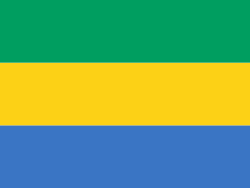 | Gabon | 3:4 | August 9, 1960 | Three equal horizontal bands of green (top), yellow, and blue. | [319][320][179][321][322] | |
 | The Gambia | 2:3 | February 18, 1965 | Louis Lucien Thomasi | Three equal horizontal bands of red (top), blue with white edges, and green. | [323][324][325][326][327] |
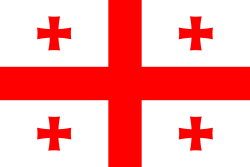 | Georgia | January 14, 2004 | — | White rectangle with a central red cross extending to all four sides of the flag; each of the four quadrants displays a small red bolnur-katskhuri cross. | [328][329][330][331][332][67][333] | |
 | Germany | 3:5 | October 3, 1990 | — | Three equal horizontal bands of black (top), red, and gold. | [334][335][336][337][338] |
 | Ghana | 2:3 | February 28, 1966 | Theodosia Okoh | Three equal horizontal bands of red (top), yellow, and green, with a large black five-pointed star centered in the yellow band. | [339][340][341][126][342] |
 | Greece | December 22, 1978 | — | Nine equal horizontal stripes of blue alternating with white; a blue square bearing a white cross appears in the upper hoist-side corner. | [343][344][39][345] | |
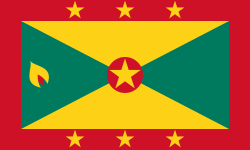 | Grenada | 3:5[j] | February 7, 1974 | Anthony C. George | A rectangle divided diagonally into yellow triangles (top and bottom) and green triangles (hoist side and outer side), with a red border around the flag; there are seven yellow, five-pointed stars with three centered in the top red border, three centered in the bottom red border, and one on a red disk superimposed at the center of the flag; there is also a symbolic nutmeg pod on the hoist-side triangle. | [346][347][348][105][349][350] |
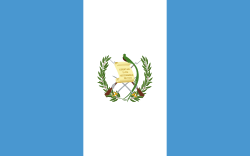 | Guatemala | 5:8 | December 26, 1997 | Juan José de Aycinena y Piñol[k] | Three equal vertical bands of light blue (hoist side), white, and light blue, with the coat of arms centered in the white band. | [351][352][353][121][354] |
 | Guinea | 2:3 | November 10, 1958 | — | Three equal vertical bands of red (hoist side), yellow, and green. | [355][356][167][357] |
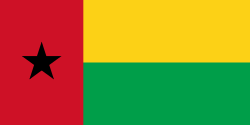 | Guinea-Bissau | 1:2 | September 24, 1973 | — | Two equal horizontal bands of yellow (top) and green with a vertical red band on the hoist side; there is a black five-pointed star centered in the red band. | [358][359][325][360] |
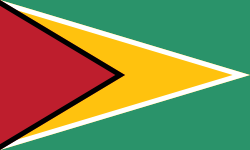 | Guyana | 3:5[l] | May 26, 1966 | Whitney Smith | Green with a red isosceles triangle (based on the hoist side) superimposed on a long, yellow arrowhead; there is a narrow, black border between the red and yellow, and a narrow, white border between the yellow and the green. | [361][362][213][363] |
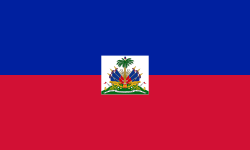 | Haiti | 3:5 | February 25, 1986 | Jean-Jacques Dessalines[m] | Two equal horizontal bands of blue (top) and red with a centered white rectangle bearing the coat of arms. | [364][365][366][87][367] |
 | Honduras | 1:2 | January 18, 1949[n] | — | Three equal horizontal bands of turquoise blue (top), white, and turquoise blue, with five turquoise, five-pointed stars arranged in an X pattern centered in the white band. | [368][369][231][370][371][372] |
 | Hungary | May 23, 1957 | — | Three equal horizontal bands of red (top), white, and green. | [373][374][251][375] | |
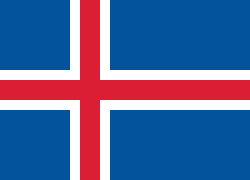 | Iceland | 18:25 | June 17, 1944 | Matthías Þórðarson | Blue with a red cross outlined in white extending to the edges of the flag; the vertical part of the cross is shifted to the hoist side in the style of the Nordic cross. | [376][377][378][379][257][380] |
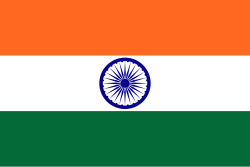 | India | 2:3 | July 22, 1947 | Pingali Venkayya | Three equal horizontal bands of saffron (subdued orange) (top), white, and green, with a blue chakra (24-spoked wheel) centered in the white band. | [381][382][100][383][384] |
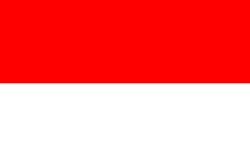 | Indonesia | August 17, 1950 | Fatmawati (allegedly) | Two equal horizontal bands of red (top) and white. | [385][386][387][157][388][389] | |
 | Iran | 4:7 | July 29, 1980 | Hamid Nadimi | Three equal horizontal bands of green (top), white, and red; the national emblem in red is centered in the white band; the Takbir in white Arabic script is repeated 11 times along the bottom edge of the green band and 11 times along the top edge of the red band. | [390][391][92][392][393][394] |
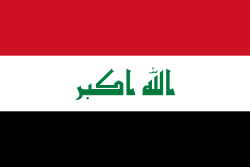 | Iraq | 2:3 | January 22, 2008 | — | Three equal horizontal bands of red (top), white, and black; the Takbir in green Arabic script is centered in the white band. | [395][396][92][397] |
 | Ireland | 1:2 | December 29, 1937 | Thomas Francis Meagher | Three equal vertical bands of green (hoist side), white, and orange. | [398][399][400][401][402][403] |
 | Israel | 8:11 | October 28, 1948 |
| White with a blue hexagram known as the Star of David centered between two equal horizontal blue bands near the top and bottom edges of the flag. | [404][405][406][407][397] |
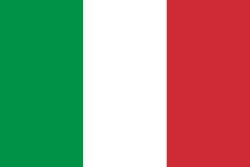 | Italy | 2:3 | January 1, 1948 | Giuseppe Compagnoni | Three equal vertical bands of green (hoist side), white, and red. | [408][409][410][411][412] |
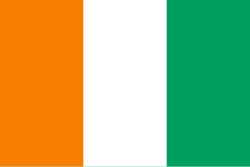 | Ivory Coast | December 3, 1959 | — | Three equal vertical bands of orange (hoist side), white, and green. | [413][414][167][415] | |
 | Jamaica | 1:2 | August 6, 1962 | — | Diagonal yellow cross divides the flag into four triangles - green (top and bottom) and black (hoist side and fly side). | [416][417][418][87][419] |
 | Japan | 2:3 | August 13, 1999 | Nichiren (allegedly) | White with a large red disk in the center. | [420][421][422][423][424] |
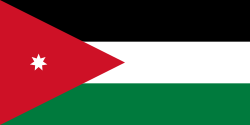 | Jordan | 1:2 | April 16, 1928[o] | — | Three equal horizontal bands of black (top), white, and green; a red isosceles triangle on the hoist side, and bearing a small white seven-pointed star. | [425][426][427][428][407][429] |
 | Kazakhstan | June 4, 1992 | Shaken Niyazbekov | A gold sun with 32 rays above a soaring golden steppe eagle, both centered on a sky blue background; the hoist side displays a national ornamental pattern "koshkar-muiz" (the horns of the ram) in gold. | [430][431][432][433][434][435] | |
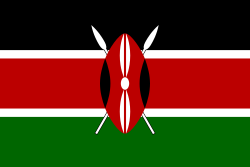 | Kenya | 2:3 | December 12, 1963 | Tom Mboya | Three equal horizontal bands of black (top), red, and green; the red band is edged in white; a large Maasai warrior's shield covering crossed spears is superimposed at the center. | [436][437][438][261][439] |
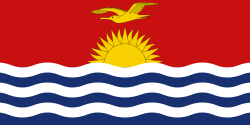 | Kiribati | 1:2 | July 12, 1979 | Arthur Grimble | The upper half is red with a yellow frigatebird flying over a yellow rising sun, and the lower half is blue with three horizontal wavy white stripes to represent the Pacific ocean. | [440][441][442][443][444] |
 | Kuwait | November 7, 1961 | — | Three equal horizontal bands of green (top), white, and red with a black trapezoid based on the hoist side. | [445][446][92][447][448] | |
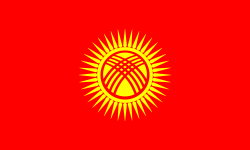 | Kyrgyzstan | 3:5 | December 26, 2023 | — | Red field with a yellow sun in the center having 40 rays; on the obverse side the rays run counterclockwise, on the reverse, clockwise; in the center of the sun is a red ring crossed by two sets of four lines, a stylized representation of a "tunduk" - the crown of a traditional Kyrgyz yurt. | [449][450][451][433][452] |
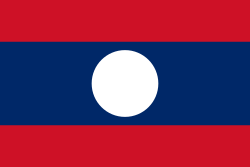 | Laos | 2:3 | December 2, 1975 | Sila Viravong | Three horizontal bands of red (top), blue (double width), and red with a large white disk centered in the blue band. | [453][454][455][175][456][457] |
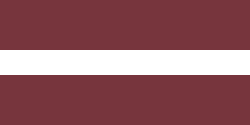 | Latvia | 1:2 | August 21, 1991 | Ansis Cīrulis | Three horizontal bands of maroon (top), white (half-width), and maroon. | [458][459][460][461][296][462] |
 | Lebanon | 2:3 | September 21, 1990 | Henri Pharaoun | Three horizontal bands consisting of red (top), white (middle, double width), and red (bottom) with a green cedar tree centered in the white band. | [463][464][465][457][407][466] |
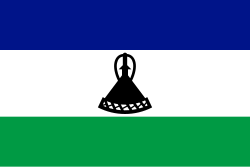 | Lesotho | October 4, 2006 | — | Three horizontal stripes of blue (top), white, and green in the proportions of 3:4:3; centered in the white stripe is a black mokorotlo, a traditional Basotho straw hat. | [467][468][300][469] | |
 | Liberia | 10:19 | August 24, 1847 |
| 11 equal horizontal stripes of red (top and bottom) alternating with white; a white five-pointed star appears on a blue square in the upper hoist-side corner | [470][471][472][167][473] |
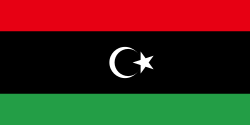 | Libya | 1:2 | August 3, 2011 | Omar Faiek Shennib | Three horizontal bands of red (top), black (double width), and green with a white crescent and star centered on the black stripe. | [474][475][476][280][477] |
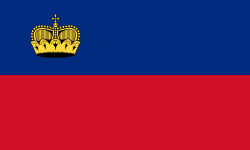 | Liechtenstein | 3:5 | September 18, 1982 | — | Two equal horizontal bands of blue (top) and red with a gold crown on the hoist side of the blue band. | [478][479][480][481] |
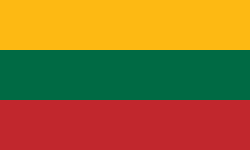 | Lithuania | March 20, 1989 | Three equal horizontal bands of yellow (top), green, and red. | [482][483][484][296][485] | ||
 | Luxembourg | 3:5[p] | March 17, 1972 | — | Three equal horizontal bands of red (top), white, and light blue. | [486][487][316][488] |
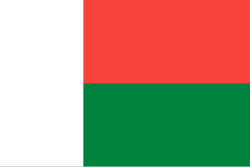 | Madagascar | 2:3 | October 1958 | Andrianome Ranaivosoa | Two equal horizontal bands of red (top) and green with a vertical white band of the same width on hoist side. | [489][490][491][492][493][217][494] |
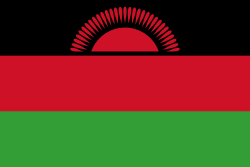 | Malawi | May 28, 2012 | — | Three equal horizontal bands of black (top), red, and green with a radiant, rising, red sun centered on the black band. | [495][496][497][498] | |
 | Malaysia | 1:2 | September 16, 1963 | Mohamed Hamzah | 14 equal horizontal stripes of red (top) alternating with white (bottom); there is a dark blue rectangle in the upper hoist-side corner bearing a yellow crescent and a yellow 14-pointed star. | [499][500][501][502][503][504] |
 | Maldives | 2:3 | July 26, 1965 | — | Red with a large green rectangle in the center bearing a vertical white crescent moon; the closed side of the crescent is on the hoist side of the flag. | [505][506][507][508] |
 | Mali | March 1, 1961 | Mariam Traore | Three equal vertical bands of green (hoist side), yellow, and red. | [509][510][511][325][512] | |
 | Malta | September 21, 1964 | — | Two equal vertical bands of white (hoist side) and red; in the upper hoist-side corner is a representation of the George Cross, edged in red. | [513][514][410][515] | |
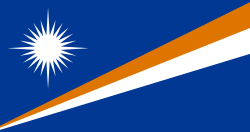 | Marshall Islands | 10:19 | May 1, 1979 | Emlain Kabua | Blue with two stripes radiating from the lower hoist-side corner - orange (top) and white; a white star with four large rays and 20 small rays appears on the hoist side above the two stripes. | [516][517][518][519] |
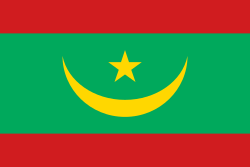 | Mauritania | 2:3 | October 12, 2017 | — | Green with a yellow, five-pointed star between the horns of a yellow, upward-pointing crescent moon; red stripes along the top and bottom edges. | [520][521][325][522][523] |
 | Mauritius | March 12, 1968 | Gurudutt Moher | Four equal horizontal bands of red (top), blue, yellow, and green. | [524][525][526][217][527] | |
 | Mexico | 4:7 | 1968 | Francisco Eppens (coat of arms) | Three equal vertical bands of green (hoist side), white, and red; Mexico's coat of arms (an eagle with a snake in its beak perched on a cactus) is centered in the white band. | [528][529][121][530][531][532][533] |
 | Micronesia | 10:19 | November 30, 1978 | Gonzalo Santos (initial version) | Light blue with four white five-pointed stars centered. | [534][535][536][537][538][539] |
 | Moldova | 1:2 | September 17, 2010 | — | Three equal vertical bands of Prussian blue (hoist side), chrome yellow, and vermilion red; the coat of arms is centered in the yellow band. | [540][541][542][543][544][545] |
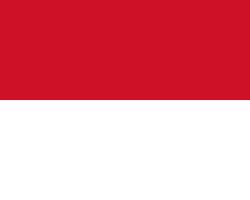 | Monaco | 4:5 | April 9, 1881 | — | Two equal horizontal bands of red (top) and white. | [546][547][47][548] |
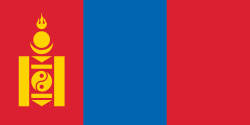 | Mongolia | 1:2 | February 12, 1992 | Dodiin Choidog | Three, equal vertical bands of red (hoist side), blue, and red; centered on the hoist-side red band in yellow is the national emblem ("soyombo" - a columnar arrangement of abstract and geometric representation for fire, sun, moon, earth, water, and the yin-yang symbol). | [549][550][207][551][552][553][554] |
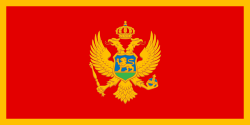 | Montenegro | September 16, 2004 | — | A red field bordered by a narrow golden-yellow stripe with the Montenegrin coat of arms centered; the arms consist of a double-headed golden eagle - symbolizing the unity of church and state - surmounted by a crown; the eagle holds a golden scepter in its right claw and a blue orb in its left; the breast shield over the eagle shows a golden lion passant on a green field in front of a blue sky. | [555][556][557][39][558] | |
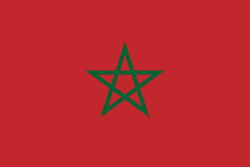 | Morocco | 2:3 | April 7, 1956 | Disputed[q] | Red with a green pentacle (five-pointed, linear star) known as the Seal of Solomon in the center of the flag. | [559][560][561][280][562][563][564] |
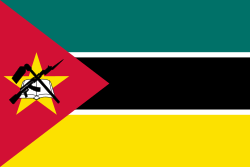 | Mozambique | May 1, 1983 | Jorge Mwanamuzik (allegedly; initial version) | Three equal horizontal bands of green (top), black, and yellow with a red isosceles triangle based on the hoist side; the black band is edged in white; centered in the triangle is a yellow five-pointed star bearing a crossed rifle and hoe in black superimposed on an open white book. | [565][566][567][568][497][569] | |
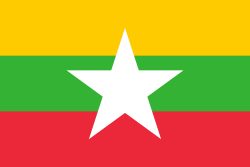 | Myanmar | October 21, 2010 | — | Design consists of three equal horizontal stripes of yellow (top), green, and red; centered on the green band is a large white five-pointed star that partially overlaps onto the adjacent colored stripes. | [570][571][507][572][573][574][575][576] | |
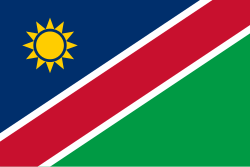 | Namibia | March 21, 1990 | Frederick Brownell | A wide red stripe edged by narrow white stripes divides the flag diagonally from lower hoist corner to upper fly corner; the upper hoist-side triangle is blue and charged with a golden-yellow, 12-rayed sunburst. | [577][578][300][579] | |
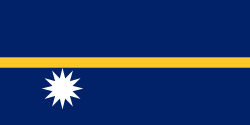 | Nauru | 1:2 | January 31, 1968 | — | Blue with a narrow, horizontal, gold stripe across the center and a large white 12-pointed star below the stripe on the hoist side. | [580][581][582][583] |
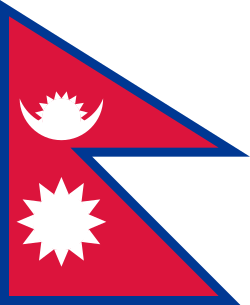 | Nepal | See Flag of Nepal § Aspect ratio ≈ 1:1.219 | December 16, 1962 | Shankar Nath Rimal | Crimson red with a blue border around the unique shape of two overlapping right triangles; the smaller, upper triangle bears a white stylized moon and the larger, lower triangle displays a white 12-pointed sun. | [584][585][586][587][588][100][589] |
 | Netherlands | 2:3 | February 19, 1937 | — | Three equal horizontal bands of red (bright vermilion; top), white, and blue (cobalt). | [590][591][592][593][116][594] |
 | New Zealand | 1:2 | November 25, 1947 | Albert Hastings Markham | Blue with the flag of the UK in the upper hoist-side quadrant with four red five-pointed stars edged in white centered in the outer half of the flag. | [595][596][597][598][594] |
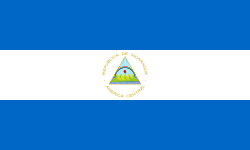 | Nicaragua | 3:5 | August 27, 1972 | — | Three equal horizontal bands of blue (top), white, and blue with the national coat of arms centered in the white band. | [599][600][231][601][602] |
 | Niger | 6:7 | August 3, 1960 | — | Three equal horizontal bands of orange (top), white, and green with a small orange disk centered in the white band. | [599][600][231][603][604] |
 | Nigeria | 1:2 | October 1, 1960 | Michael Taiwo Akinkunmi | Three equal vertical bands of green (hoist side), white, and green. | [605][606][126][607] |
 | North Korea | September 8, 1942 | Disputed[r] | Three horizontal bands of blue (top), red (triple width), and blue; the red band is edged in white; on the hoist side of the red band is a white disk with a red five-pointed star. | [608][609][422][610][611][435] | |
 | North Macedonia | October 5, 1995 | Miroslav Grčev | A yellow sun (the Sun of Liberty) with eight broadening rays extending to the edges of the red field. | [612][613][39][614][615][616] | |
 | Norway | 8:11 | June 7, 1905 (retained at independence) | Christian Frederick of Norway | Red with a blue cross outlined in white that extends to the edges of the flag; the vertical part of the cross is shifted to the hoist side in the style of the Nordic cross. | [617][618][257][619][620] |
 | Oman | 4:7[s] | April 25, 1995 | Qaboos bin Sa'id Al-Sa'id | Three horizontal bands of white (top), red, and green of equal width with a broad, vertical, red band on the hoist side; the national emblem (a khanjar dagger in its sheath superimposed on two crossed swords in scabbards) in white is centered near the top of the vertical band. | [621][622][623][624][625][563] |
 | Pakistan | 2:3 | August 14, 1947 | Syed Amir-uddin Kedwaii | Green with a vertical white band on the hoist side; a large white crescent and star are centered in the green field. | [626][627][100][628][629] |
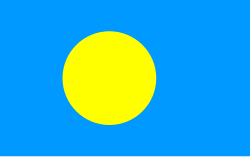 | Palau | 5:8 | October 1, 1994 | Blau Skebong | Light blue with a large yellow disk shifted slightly to the hoist side. | [630][631][536][632][633][634][635] |
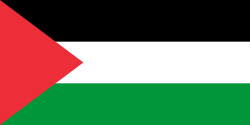 | Palestine | 1:2 | November 15, 1988 | — | Three equal horizontal bands of black (top), white, and green with a red isosceles triangle based on the hoist side. | [636][407][637][629][638] |
 | Panama | 2:3 | June 6, 1904 | Disputed[t] | Divided into four, equal rectangles; the top quadrants are white (hoist side) with a blue five-pointed star in the center and plain red; the bottom quadrants are plain blue (hoist side) and white with a red five-pointed star in the center. | [639][640][231][641][642][643] |
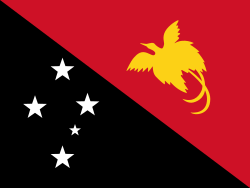 | Papua New Guinea | 3:4 | September 16, 1975 | Karike Susan | Divided diagonally from upper hoist-side corner; the upper triangle is red with a soaring yellow bird of paradise centered; the lower triangle is black with five, white, five-pointed stars of the Southern Cross constellation centered. | [644][645][582][646] |
 Paraguay (obverse) | Paraguay | 11:20[u] | July 15, 2013 | — | Three equal, horizontal bands of red (top), white, and blue with an emblem centered in the white band; the emblem is different on each side; the obverse (hoist side at the left) bears the national coat of arms; the reverse (hoist side at the right) bears a circular seal of the treasury. | [647][648][61][649][650][651][652] |
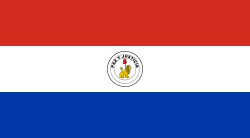 Paraguay (reverse) | — | |||||
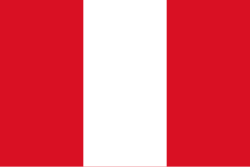 | Peru | 2:3 | February 25, 1825 | José de San Martín (initial version) | Three equal, vertical bands of red (hoist side), white, and red. | [653][654][61][655] |
 | Three equal, vertical bands of red (hoist side), white, and red with the coat of arms centered in the white band. | |||||
 | Philippines | 1:2 | September 16, 1997 | Emilio Aguinaldo[v] | Two equal horizontal bands of blue (top) and red; a white equilateral triangle is based on the hoist side; the center of the triangle displays a yellow sun with eight primary rays; each corner of the triangle contains a small, yellow, five-pointed star. | [656][657][175][658][659] |
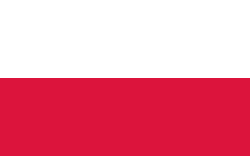 | Poland | 5:8 | August 1, 1919 | — | Two equal horizontal bands of white (top) and red. | [660][661][251][662] |
 | Portugal | 2:3 | June 11, 1911 | Columbano Bordalo Pinheiro | Two vertical bands of green (hoist side, two-fifths) and red (three-fifths) with the national coat of arms (armillary sphere and Portuguese shield) centered on the dividing line. | [663][664][665][666][667] |
 | Qatar | 11:28 | July 9, 1971 | Abdullah bin Jassim Al Thani | Maroon with a broad white serrated band (nine white points) on the hoist side. | [668][669][665][670][671][672] |
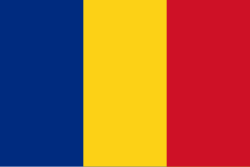 | Romania | 2:3 | December 27, 1989 | — | Three equal vertical bands of cobalt blue (hoist side), chrome yellow, and vermilion red. | [673][674][162][675] |
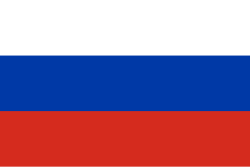 | Russia | December 11, 1991 | Peter I of Russia | Three equal horizontal bands of white (top), blue, and red. | [676][677][109][678][670] | |
 | Rwanda | December 31, 2001 | Alphonse Kirimobenecyo | Three horizontal bands of sky blue (top, double width), yellow, and green, with a golden sun with 24 rays near the fly end of the blue band. | [679][680][171][681][682][683] | |
 | Saint Kitts and Nevis | November 19, 1983 | Edrice Lewis | Divided diagonally from the lower hoist side by a broad black band bearing two white, five-pointed stars; the black band is edged in yellow; the upper triangle is green, the lower triangle is red. | [684][685][57][686] | |
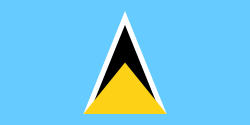 | Saint Lucia | 1:2 | February 22, 1979 | Dunstan St. Omer | Cerulean blue with a gold isosceles triangle below a black arrowhead; the upper edges of the arrowhead have a white border. | [687][688][57][689] |
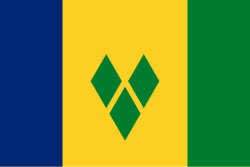 | Saint Vincent and the Grenadines | 2:3 | October 22, 1985 | Julien van der Wal | Three vertical bands of blue (hoist side), gold (double width), and green; the gold band bears three green diamonds arranged in a V pattern. | [690][691][105][692] |
 | Samoa | 1:2 | January 1, 1962 | Red with a blue rectangle in the upper hoist-side quadrant bearing five white, five-pointed stars representing the Southern Cross constellation. | [693][694][518][695][696][697][698] | |
 | San Marino | 3:4 | July 22, 2011 | — | Two equal horizontal bands of white (top) and light blue with the national coat of arms superimposed in the center; the main colors derive from the shield of the coat of arms, which features three white towers on three peaks on a blue field; the towers represent three castles built on San Marino's highest feature, Mount Titano: Guaita, Cesta, and Montale; the coat of arms is flanked by a wreath, below a crown and above a scroll bearing the word LIBERTAS (lit. 'liberty'). | [699][700][410][701] |
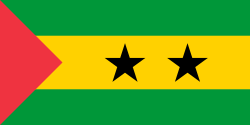 | São Tomé and Príncipe | 1:2 | November 5, 1975 | Manuel Pinto da Costa | Three horizontal bands of green (top), yellow (double width), and green with two black five-pointed stars placed side by side in the center of the yellow band and a red isosceles triangle based on the hoist side. | [702][703][126][704][705] |
 | Saudi Arabia | 2:3 | March 15, 1973 | — | Green with the Shahada in large white Thuluth script. Hoist side depicted to right. | [706][707][407][708][709][710] |
 | Senegal | August 20, 1960 | — | Three equal vertical bands of green (hoist side), yellow, and red with a small green five-pointed star centered in the yellow band. | [711][712][325][713] | |
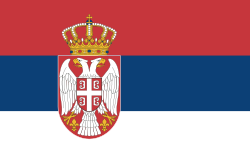 | Serbia | November 11, 2010 | — | Three equal horizontal stripes of red (top), blue, and white charged with the coat of arms of Serbia shifted slightly to the hoist side; the principal field of the coat of arms displays a white two-headed eagle on a red shield; a smaller red shield on the eagle is divided into four quarters by a white cross. | [714][715][143][716][717] | |
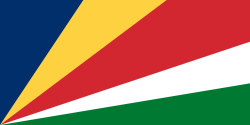 | Seychelles | 1:2 | June 18, 1996 | Philippe Uzice | Five oblique bands of blue (hoist side), yellow, red, white, and green (bottom) radiating from the bottom of the hoist side. | [718][719][217][720][721][722] |
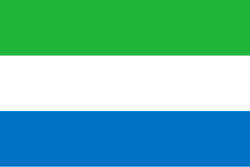 | Sierra Leone | 2:3 | April 27, 1961 | — | Three equal horizontal bands of light green (top), white, and light blue. | [723][724][167][725] |
 | Singapore | August 9, 1965 | Toh Chin Chye[w] | Two equal horizontal bands of red (top) and white; near the hoist side of the red band, there is a vertical, white crescent (closed portion is toward the hoist side) partially enclosing five white five-pointed stars arranged in a circle. | [726][727][157][728][729][730][708] | |
 | Slovakia | January 1, 1993 |
| Three equal horizontal bands of white (top), blue, and red; the Slovakian coat of arms (consisting of a red shield bordered in white and bearing a white double-barred cross of Cyril and Methodius surmounting three blue hills) is centered over the bands but offset slightly to the hoist side. | [731][732][251][733][734][735] | |
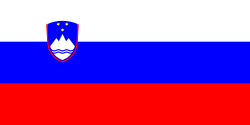 | Slovenia | 1:2 | June 25, 1991 | — | Three equal horizontal bands of white (top), blue, and red; the coat of arms of Slovenia (a shield with the image of Triglav, Slovenia's highest peak, in white against a blue background at the center; beneath it are two wavy blue lines depicting seas and rivers, and above it are three six-pointed stars arranged in an inverted triangle) appears in the upper hoist side of the flag centered on the white and blue bands. | [736][737][410][738][739][740] |
 | Solomon Islands | July 7, 1978 | Disputed[x] | Divided diagonally by a thin yellow stripe from the lower hoist-side corner; the upper triangle (hoist side) is blue with five white five-pointed stars arranged in an X pattern; the lower triangle is green. | [741][742][582][743][744][745] | |
 | Somalia | 2:3 | July 1, 1960 | Mohammed Awale Liban | Light blue with a large white five-pointed star in the center. | [746][747][261][748][749][750] |
 | South Africa | April 27, 1994 | Frederick Brownell | Two equal width horizontal bands of red (top) and blue separated by a central green band that splits into a horizontal Y, the arms of which end at the corners of the hoist side; the Y embraces a black isosceles triangle from which the arms are separated by narrow yellow bands; the red and blue bands are separated from the green band and its arms by narrow white stripes. | [751][752][300][753][754] | |
 | South Korea | October 1997 | Lee Eung-jun | White with a red (top) and blue taijitu in the center; there is a different black trigram from the I Ching in each corner of the white field. | [755][756][422][757][758] | |
 | South Sudan | 1:2 | July 9, 2011 | — | Three equal horizontal bands of black (top), red, and green; the red band is edged in white; a blue isosceles triangle based on the hoist side contains a gold, five-pointed star. | [759][760][171][761][762][763] |
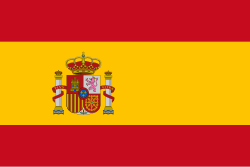 | Spain | 2:3 | October 28, 1981 | Antonio Valdés y Fernández Bazán | Three horizontal bands of red (top), yellow (double width), and red with the national coat of arms on the hoist side of the yellow band. | [764][765][766][767][768][769] |
 | Sri Lanka | 1:2 | 1978 | — | Yellow with two panels; the smaller hoist-side panel has two equal vertical bands of green (hoist side) and orange; the other larger panel depicts a yellow lion holding a sword on a maroon rectangular field that also displays a yellow bo leaf in each corner; the yellow field appears as a border around the entire flag and extends between the two panels. | [770][771][772][773][774] |
 | Sudan | May 20, 1970 | Abd al-Raḥman Aḥmad al-Jali | Three equal horizontal bands of red (top), white, and black with a green isosceles triangle based on the hoist side. | [762][775][776][171][777][778] | |
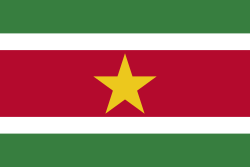 | Suriname | 2:3 | November 25, 1975 | Jack Pinas | Five horizontal bands of green (top, double width), white, red (quadruple width), white, and green (double width); a large, yellow, five-pointed star is centered in the red band. | [779][780][781][782][783] |
 | Sweden | 5:8 | June 22, 1906 | — | Blue with a golden yellow cross extending to the edges of the flag; the vertical part of the cross is shifted to the hoist side in the style of the Nordic cross. | [784][785][312][786][787] |
 | Switzerland | 1∶1 | December 12, 1889 | — | Red square with a bold, equilateral white cross in the center that does not extend to the edges of the flag. | [788][789][480][790] |
 | Syria[y] | 2:3 | December 8, 2024 | — | Three equal horizontal bands of green, white, and black; three small, red, five-pointed stars in a horizontal line centered in the white band. | [791][792][793] |
 | Tajikistan | 1:2 | November 24, 1992 | Zuhur Habibullaev[z] | Three horizontal stripes of red (top), a wider stripe of white, and green; a gold crown surmounted by seven gold, five-pointed stars is located in the center of the white stripe. | [794][795][34][796][797][798] |
 | Tanzania | 2:3 | June 30, 1964 | — | Divided diagonally by a yellow-edged black band from the lower hoist-side corner; the upper triangle (hoist side) is green and the lower triangle is blue. | [799][800][497][801] |
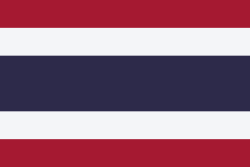 | Thailand | September 28, 1917 | Vajiravudh | Five horizontal bands of red (top), white, blue (double width), white, and red. | [802][803][507][804] | |
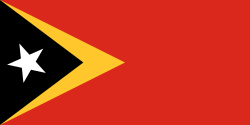 | Timor-Leste | 1:2 | May 20, 2002 | Natalino Leitão | Red with a black isosceles triangle (based on the hoist side) superimposed on a slightly longer yellow arrowhead that extends to the center of the flag; a white star - pointing to the upper hoist-side corner of the flag - is in the center of the black triangle. | [805][806][807][808][157][809][810] |
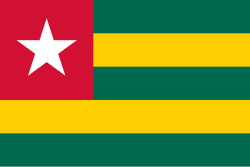 | Togo | Unclear[aa] | April 27, 1960 | Paul Ahyi | Five equal horizontal bands of green (top and bottom) alternating with yellow; a white five-pointed star on a red square is in the upper hoist-side corner. | [811][812][126][813][814][815] |
 | Tonga | 1:2 | November 4, 1875 | Shirley Waldemar Baker | Red with a bold red cross on a white rectangle in the upper hoist-side corner. | [816][817][307][818][819] |
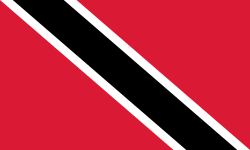 | Trinidad and Tobago | 3:5 | August 31, 1962 | Carlisle Chang | Red with a white-edged black diagonal band from the upper hoist side to the lower fly side. | [820][821][105][822][823] |
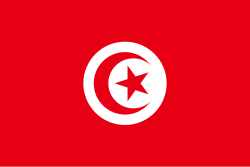 | Tunisia | 2:3 | July 3, 1999 | — | Red with a white disk in the center bearing a red crescent nearly encircling a red five-pointed star. | [824][825][105][826] |
 | Turkey | May 29, 1936 | — | Red with a vertical white crescent moon (the closed portion is toward the hoist side) and white five-pointed star centered just outside the crescent opening. | [827][828][162][829] | |
 | Turkmenistan | January 24, 2001 | — | Green field with a vertical red stripe near the hoist side, containing five tribal guls stacked above two crossed olive branches; five white, five-pointed stars and a white crescent moon appear in the upper corner of the field just to the fly side of the red stripe. | [830][831][433][832][833] | |
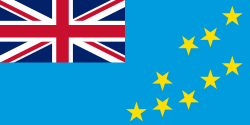 | Tuvalu | 1:2 | April 11, 1997 | Vione Natano | Light blue with the flag of the United Kingdom in the upper hoist-side quadrant; the outer half of the flag represents a map of the country with nine yellow, five-pointed stars on a blue field. | [834][835][518][836] |
 | Uganda | 2:3 | October 9, 1962 | Grace Ibingira | Six equal horizontal bands of black (top), yellow, red, black, yellow, and red; a white disk is superimposed at the center and depicts a grey crowned crane (the national symbol) facing the hoist side. | [837][838][497][839] |
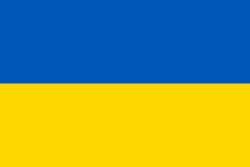 | Ukraine | January 21, 1992 | — | Two equal horizontal bands of azure (top) and golden yellow. | [840][841][542][842] | |
 | United Arab Emirates | 1:2 | December 2, 1971 | Abdullah Mohammed Al Maainah | Three equal horizontal bands of green (top), white, and black with a wider vertical red band on the hoist side. | [843][844][623][845][846][847] |
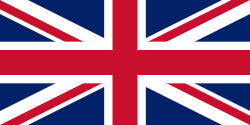 | United Kingdom | 1:2[ab] | January 1, 1801 | — | Blue field with the red cross of Saint George edged in white superimposed on the diagonal red saltire of Saint Patrick, which is superimposed on the diagonal white cross of Saint Andrew. | [848][849][401][850][851] |
 | United States | 10:19 | July 4, 1960 | Disputed[ac] | 13 equal horizontal stripes of red (top and bottom) alternating with white; there is a blue rectangle in the upper hoist-side corner bearing 50 small, white, five-pointed stars arranged in nine offset horizontal rows of six stars (top and bottom) alternating with rows of five stars. | [852][853][854][855][856][857] |
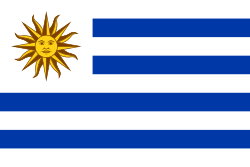 | Uruguay | 2:3 | July 11, 1830 | Joaquín Suárez | Nine equal horizontal stripes of white (top and bottom) alternating with blue; a white square in the upper hoist-side corner with a yellow sun bearing a human face (delineated in black) known as the Sun of May with 16 rays that alternate between triangular and wavy. | [858][859][860][861] |
 | Uzbekistan | 1:2 | November 18, 1991 | — | Three equal horizontal bands of blue (top), white, and green separated by red fimbriations with a vertical, white crescent moon (closed side to the hoist) and 12 white, five-pointed stars shifted to the hoist on the top band. | [862][863][433][864] |
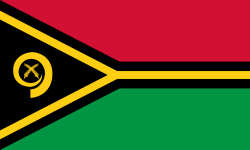 | Vanuatu | 3:5 | July 30, 1980 | Kalontas Malon | Two equal horizontal bands of red (top) and green with a black isosceles triangle (based on the hoist side) all separated by a black-edged yellow stripe in the shape of a horizontal Y (the two points of the Y face the hoist side and enclose the triangle); centered in the triangle is a boar's tusk encircling two crossed namele fern fronds, all in yellow. | [865][866][582][867][868] |
 | Vatican City | 1∶1 | June 7, 1929 | — | Two vertical bands of yellow (hoist side) and white with the arms of the Holy See, consisting of the crossed keys of Saint Peter surmounted by the three-tiered papal tiara, centered in the white band. | [869][870][410][867][871] |
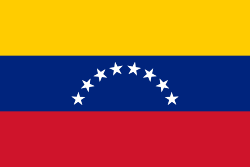 | Venezuela | 2:3 | March 9, 2006 | — | Three equal horizontal bands of yellow (top), blue, and red. | [872][873][213][874] |
 | — | Three equal horizontal bands of yellow (top), blue, and red with the coat of arms on the hoist side of the yellow band and an arc of eight white five-pointed stars centered in the blue band. | ||||
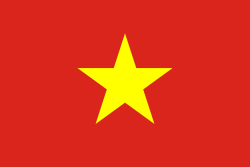 | Vietnam | July 2, 1976 | Disputed[ad] | Red field with a large yellow five-pointed star in the center. | [875][876][175][877][878][879] | |
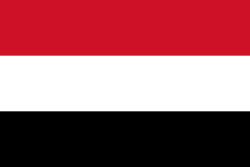 | Yemen | May 22, 1990 | — | Three equal horizontal bands of red (top), white, and black. | [880][881][623][882][883] | |
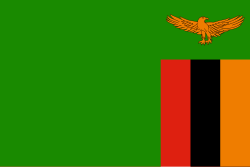 | Zambia | April 13, 1996 | Gabriel Ellison | Green field with a panel of three vertical bands of red (hoist side), black, and orange below a soaring orange eagle, on the outer edge of the flag. | [884][885][497][886][887] | |
 | Zimbabwe | 1:2 | April 18, 1980 | Cedric Herbert | Seven equal horizontal bands of green (top), yellow, red, black, red, yellow, and green with a white isosceles triangle edged in black with its base on the hoist side; a yellow Zimbabwe Bird is superimposed on a red five-pointed star in the center of the triangle. | [888][889][300][890][891] |
Flags of de facto states
[edit]| Flag(s) | State | Aspect ratio | Date of latest adoption | Designer(s) | Description | Refs. |
|---|---|---|---|---|---|---|
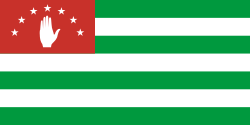 | Abkhazia | 1:2 | July 23, 1992 | Valery Gamgia | Seven equal horizontal stripes of green (top and bottom) alternating with white; a red rectangle in the upper hoist-side corner with a white dexter hand appaumé below an arc of seven white five-pointed stars. | [67][892] |
 | Kosovo | 5:7 | February 17, 2008 | Muhamer Ibrahimi | Centered on a dark blue field is a gold-colored silhouette map of Kosovo surmounted by six white, five-pointed stars arrayed in a slight arc. | [893][894][895][890][896][897] |
 | Northern Cyprus | 2:3 | March 13, 1984 | Emin Çizenel | White with a vertical red crescent moon (the closed portion is toward the hoist side) and red five-pointed star centered just outside the crescent opening centered between two equal horizontal red bands near the top and bottom edges of the flag. | [162][638][898] |
 | Sahrawi Arab Democratic Republic | 1:2 | February 27, 1976 | El-Ouali Mustapha Sayed | Three equal horizontal bands of black (top), white, and green with a red isosceles triangle based on the hoist side. a red, five-pointed star and crescent (the closed portion is toward the hoist side) centered in the white band. | [325][899] |
 | Somaliland | October 14, 1996 | — | Three equal horizontal bands of green (top), white, and red; a white Shahada centered in the green band; a black, five-pointed star centered in the white band. | [261][899] | |
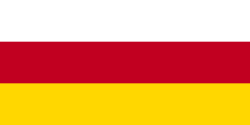 | South Ossetia | c. 1990 | — | Three equal horizontal bands of white (top), red, and yellow. | [899] | |
 | Taiwan | 2:3 | October 28, 1928 |
| Red field with a dark blue rectangle in the upper hoist-side corner bearing a white sun with 12 triangular rays. | [900][901][902][903][904] |
 | Transnistria | 1:2 | July 3, 2000 | — | Three horizontal bands of red (top), green (half-width), and red with a yellow hammer and sickle below a yellow outline of a five-pointed star in the upper hoist-side corner of the top band. | [542][899] |
 Russia[ae] | 1:2[af] | April 12, 2017 | Peter I of Russia | Three equal horizontal bands of white (top), blue, and red. | [905][906][ag] |
See also
[edit]- Flag families
- List of national flags by design
- Gallery of sovereign state flags
- Gallery of flags of dependent territories
Notes
[edit]- ^ This refers to the date on which the most recent law or proclamation relating to the design of a flag was established by the government of a sovereign state post-independence, or the date of independence if the flag was legally adopted by a prenational government and retained on independence, but was never modified afterwards.
- ^ The ruling Islamic Emirate of Afghanistan remains unrecognized. Therefore, the flag of the defunct Islamic Republic of Afghanistan continues to be used in some contexts, mostly outside Afghanistan.[25][26]
- ^
 Media related to Emblem of Afghanistan (2004–2021) at Wikimedia Commons
Media related to Emblem of Afghanistan (2004–2021) at Wikimedia Commons - ^ The designer of the flag is disputed between Émilie Busquant and Chawki Mostefaï.
- ^ Also known as the Australian National Flag
- ^ The current flag is an adaptation of the original Soviet design by Mikhail Gusyev
- ^ Sources contradict as to the designer of the flag. The following have been given as the flag's designer:
- Bernardo O'Higgins and José Ignacio Zenteno
- José Ignacio Zenteno (sole credit)
- Carlos Wood
- ^ Gauthier designed the previous version of the flag, which the current one is based on.
- ^ Denmark as a sovereign state is represented by the flag of Metropolitan Denmark, which excludes the Faroe Islands and Greenland.
- ^ When used as an ensign, the ratio is 1:2.
- ^ The design adopted by the government was based on the proposal of Aycinena y Piñol and other members of the Aycinena Clan
- ^ When used as an ensign, the ratio is 1:2.
- ^ According to an apocryphal story, Catherine Flon is also credited.
- ^ Between 1955 and 2022, the Honduran government erroneously used a design with a navy blue color instead of the specified turquoise blue. With the inauguration of president Xiomara Castro, the correct colors were restored.
- ^ Between March and July 1958, Jordan and Iraq merged into the Arab Federation which bore a similar flag to that of Jordan, albeit without the star. Nevertheless, the flag of Jordan itself is considered to "have not changed since its independence."
- ^ Although 3:5 is generally used, 1:2 is also accepted.
- ^ It has been claimed French general Hubert Lyautey personally designed the flag, however he only played a minor role in the process of its adoption. The design for the flag only emerged through negotiations between the French administration and the Makhzen.
- ^ See Flag of North Korea#Creation
- ^ Ratios of 1:2 and 5:9 are sometimes used.
- ^ Either Manuel Amador Guerrero or his son Manuel Encarnacíon Guerrero. Some have also suggested the former's wife María de la Ossa de Amador, although this is considered unlikely.
- ^ The decree of July 2013 specifies a proportion of "1:0.55" for the "larger and smaller dimensions" respectively.
- ^ With help from Marcela Agoncillo, her daughter Lorenza, and Delfina Herbosa de Natividad
- ^ Deputy Prime Minister Toh designed the flag with two civil servants.
- ^ Solomonese artist Thomas Giosa claimed to have submitted the winning design in a competition in 1975, however an unnamed New Zealand visual artist also claimed ownership of the design.
- ^ Following the Fall of Damascus in December 2024, the official flag of Syria used by the de facto Syrian transitional government differs from the flag used by the ousted Ba'athist government.[791]
- ^ Habibullaev led a committee to design the national flag.
- ^ 2:3 and "approximately 3:5" have been given as the flag's ratio. It has also been claimed the proportions are golden.
- ^ 2:3 aspect ratio is a valid alternative
- ^ Robert Heft has claimed, and has been credited by some sources, as the designer of the 50-star flag. However, this has been thoroughly disputed by Slate writer Alec Nevala-Lee who has instead suggested William R. Furlong as the flag's true designer.
- ^ The designer of the flag is disputed between Nguyễn Hữu Tiến and Lê Quang Sô.
- ^ According to an April 2017 law passed by the Supreme Council, the national flag of Russia is co-officially the national flag of Transnistria.
- ^ The aspect ratio differs from the flag adopted by Russia, which is 3:2.
- ^ See the entry for Russia for further references.
References
[edit]- ^ "national flag". Collins English Dictionary. Glasgow: HarperCollins. Retrieved August 18, 2024.
- ^ Rosenberg, Matt (August 18, 2024). "Differences Between a Country, State, and Nation". ThoughtCo. Archived from the original on August 2, 2024. Retrieved August 18, 2024.
- ^ Tóth, Zoltán (2022), "The Protection of State and National Symbols Across Europe: An Overview of Constitutional Law and Criminal Law Regulations", Constitutional and Legal Protection of State and National Symbols in Central Europe, Studies of the Central European Professors' Network, Miskolc, Budapest: Central European Academic Publishing, p. 39, doi:10.54237/profnet.2022.ztclpsnsce_2, ISBN 978-615-6474-18-6, retrieved August 17, 2024
- ^ Cerulo, Karen A. (June 1, 1993). "Symbols and the world system: National anthems and flags". Sociological Forum. 8 (2): 244. doi:10.1007/BF01115492. ISSN 1573-7861.
- ^ Eriksen, Thomas Hylland; Jenkins, Richard (October 18, 2007). Flag, Nation and Symbolism in Europe and America. Routledge. pp. 334–350. ISBN 978-1-134-06695-7.
- ^ Becker, Julia C.; Butz, David A.; Sibley, Chris G.; Barlow, Fiona Kate; Bitacola, Lisa M.; Christ, Oliver; Khan, Sammyh S.; Leong, Chan-Hoong; Pehrson, Samuel; Srinivasan, Narayanan; Sulz, Aline; Tausch, Nicole; Urbanska, Karolina; Wright, Steven C. (2017). "What Do National Flags Stand for? An Exploration of Associations Across 11 Countries". Journal of Cross-Cultural Psychology. 48 (3): 336. doi:10.1177/0022022116687851. hdl:10023/9858. ISSN 0022-0221.
- ^ Znamierowski 2020, p. 100.
- ^ Smith, Whitney (1975). Flags through the ages and across the world. New York: McGraw-Hill. p. 32. ISBN 978-0-07-059093-9.
- ^ Brownell, Frederick Gordon (2015). Convergence and Unification: the national flag of South Africa (1994) in historical perspective (PDF) (PhD thesis). University of Pretoria. p. 23. Retrieved September 7, 2024.
- ^ "sovereign state". Oxford English Dictionary (Online ed.). Oxford University Press. doi:10.1093/OED/4449227925. (Subscription or participating institution membership required.)
- ^ Visoka, Gëzim; Doyle, John; Newman, Edward, eds. (September 12, 2019). Routledge Handbook of State Recognition (1 ed.). Abingdon, Oxon; New York: Routledge. pp. 1–2. doi:10.4324/9781351131759. ISBN 978-1-351-13175-9.
- ^ a b Ker-Lindsay, James (January 28, 2022), "De Facto States in the 21st Century", Oxford Research Encyclopedia of International Studies, doi:10.1093/acrefore/9780190846626.013.635, ISBN 978-0-19-084662-6, retrieved August 5, 2024
- ^ Dedinger, Béatrice; Girard, Paul (October 2, 2021). "How many countries in the world? The geopolitical entities of the world and their political status from 1816 to the present". Historical Methods: A Journal of Quantitative and Interdisciplinary History. 54 (4): 208–227. doi:10.1080/01615440.2021.1939826. ISSN 0161-5440.
- ^ Düerkop, Sascha; Ganohariti, Ramesh (October 2, 2021). "Sovereignty in sports: non-sovereign territories in international football". International Journal of Sport Policy and Politics. 13 (4): 681. doi:10.1080/19406940.2021.1947347. ISSN 1940-6940.
- ^ Küçükşener, Ebru; Sonan, Sertac; Gokcekus, Omer (January 11, 2024). "Internal Legitimacy in a De Facto State: The Case of the Turkish Republic of Northern Cyprus". Geopolitics. 30: 156–185. doi:10.1080/14650045.2023.2296918. ISSN 1465-0045.
- ^ Kopeček, Vincenc; Hoch, Tomáš; Baar, Vladimír (May 1, 2016). "De Facto States and Democracy: The Case of Abkhazia". Bulletin of Geography. Socio-economic Series. 32 (32): 85–104. doi:10.1515/bog-2016-0017. ISSN 2083-8298.
- ^ Toal (Gearóid Ó Tuathail), Gerard; O'Loughlin, John (2013). "Inside South Ossetia: a survey of attitudes in a de facto state". Post-Soviet Affairs. 29 (2): 136–172. doi:10.1080/1060586X.2013.780417. ISSN 1060-586X.
- ^ Balmaceda, Margarita M. (December 1, 2013). "Privatization and elite defection in de facto states: The case of Transnistria, 1991–2012". Communist and Post-Communist Studies. 46 (4): 445–454. doi:10.1016/j.postcomstud.2013.08.001. ISSN 0967-067X.
- ^ Caspersen, Nina (January 1, 2008). "From Kosovo to Karabakh: International Responses to De Facto States". Comparative Southeast European Studies. 56 (1): 58–83. doi:10.1515/soeu-2008-560105. ISSN 2701-8202.
- ^ Mormul, Joanna; Kłosowicz, Robert (June 27, 2024). "A de facto state's struggle for international recognition: The case of the Sahrawi Arab Democratic Republic". Stosunki Międzynarodowe – International Relations. 4: 6. doi:10.12688/stomiedintrelat.17789.1. Retrieved August 5, 2024.
- ^ Johnson, Martha C.; Smaker, Meg (2014). "State Building in De Facto States: Somaliland and Puntland Compared". Africa Today. 60 (4): 3–23. doi:10.2979/africatoday.60.4.3. ISSN 1527-1978.
- ^ Marshall, Tim (July 4, 2017). A Flag Worth Dying For: The Power and Politics of National Symbols. Simon and Schuster. p. 86. ISBN 978-1-5011-6833-8.
- ^ a b Thomas, Alastair H. (July 26, 2016). "Flag". Historical Dictionary of Denmark. Rowman & Littlefield. ISBN 978-1-4422-6465-6.
- ^ Nations, United. "UN at a glance". United Nations. Retrieved August 19, 2024.
- ^ Putz, Catherine (February 9, 2022). "Conflict Over Afghanistan's UN Seat Widens". The Diplomat. Retrieved August 4, 2024.
- ^ Sayar, Milad (July 28, 2024). "Afghanistan's flag has changed 12 times in 105 years". Amu tv. Archived from the original on August 18, 2024. Retrieved August 18, 2024.
- ^ a b Chughtai, Alia; Moslih, Hashmat (August 21, 2021). "Infographic: Afghanistan's flags over the years". Al Jazeera. Retrieved August 4, 2024.
- ^ "Flag and Emblem Law of the Islamic Emirate of Afghanistan" (in Pashto). Afghanistan Center at Kabul University. pp. 6–7. Archived from the original on August 18, 2022. Retrieved April 24, 2022.
- ^ "Amendments to the Flag and Emblem Law of the Islamic Emirate of Afghanistan". September 20, 1997. Archived from the original on June 3, 2019. Retrieved August 21, 2021.
- ^ Holtmann, Philipp (January 16, 2013), "The Symbols of Online Jihad", in Lohlker, Rüdiger (ed.), Jihadism: Online Discourses and Representations, Studying Jihadism, vol. 2 (1 ed.), Göttingen: V&R unipress, pp. 9–64, doi:10.14220/9783737000680.9, ISBN 978-3-8471-0068-3
- ^
 This article incorporates public domain material from "Afghanistan/flag". The World Factbook (2025 ed.). CIA.
This article incorporates public domain material from "Afghanistan/flag". The World Factbook (2025 ed.). CIA. - ^ Whitney Smith, Flag of Afghanistan at the Encyclopædia Britannica
- ^ Porsche-Ludwig & Chen 2022b, p. 799.
- ^ a b Znamierowski 2020, p. 169.
- ^ Mumford 2021, p. 260.
- ^ Whitney Smith, Flag of Albania at the Encyclopædia Britannica
- ^
 This article incorporates public domain material from "Albania/flag". The World Factbook (2025 ed.). CIA.
This article incorporates public domain material from "Albania/flag". The World Factbook (2025 ed.). CIA. - ^ Elsie, Robert (2010). "FLAG, ALBANIAN". Historical Dictionary of Albania. Rowman & Littlefield. ISBN 978-0-8108-6188-6.
- ^ a b c d Znamierowski 2020, p. 156.
- ^ Mumford 2021, p. 220.
- ^ Whitney Smith, Flag of Algeria at the Encyclopædia Britannica
- ^
 This article incorporates public domain material from "Algeria/flag". The World Factbook (2025 ed.).
This article incorporates public domain material from "Algeria/flag". The World Factbook (2025 ed.).


 French
French Deutsch
Deutsch